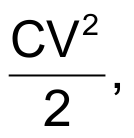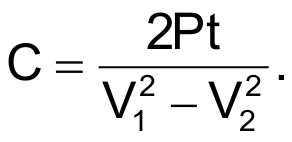This Design Idea shows how to keep telecom equipment operational during a short brownout. You must first understand a few details regarding the power supply for telecom equipment. The common voltage of the power source that feeds telecom equipment is –48 V, although the actual voltage can range from –42.5 to –56 V, –40 to –60 V, or even beyond. The common power-“brick” dc/dc converter operates over the –36 to –75 V range. A brownout occurs when the –48 V source drops to 0 V and stays there as long as 10 msec.
Using capacitive storage that connects to the brick’s input is an obvious approach to overcoming this problem, but a shortcoming becomes apparent when you understand the reality of the –48 V supply. For example the energy in a capacitor charged to voltage is

where C is the capacitance and V is the voltage. The brick stops its operation when the capacitor discharges to 36 V. In general, the energy available to support the brick’s operation is, therefore:

where V1 and V2 are the beginning and final –36 V voltages, respectively, and U is the energy. Also,

where P is power and t is time. Using these equations, you can find the time that the equipment will stay operational:

or, to define the capacitor’s value:

Assume that the brownout occurs when the voltage at the brick’s input is –39 V, which is the case when –48 V is –40 V but the brick loses at least 1 V because of protective ORed diodes in a hot-swap configuration. Also, assume that the storage capacitor charges to –39 V. The equipment operates until this storage capacitor discharges to –36 V. Assume that the equipment consumes 100 W. To store enough energy for 5 msec, the capacitor’s value would have to be approximately 4500 µF. The capacitor must be rated for the maximum possible incoming voltage, which can be more than 75 V, so the minimum rating of 100 V is a must. The 4500-µF, 100 V capacitor is a sizable part. If the design requires twice as much operational time at a power consumption of 300 W, the capacitor must have a value of 27,000 µF and 100 V.
This Design Idea still requires a capacitor, but the capacitor has a lower value – that is, 200 µF versus 4500 µF – and sustains 100 W during a 5-msec brownout. This approach increases reliability and reduces cost and size. The hidden feature is the power brick’s ability to stay operational over the input range of –36 to –75 V and even to operate under surges greater than –80 V. Figure 1 shows how you can use this feature. The figure depicts a positive input voltage. The brick is isolated, so polarity is irrelevant, but positive interpretation is easier to illustrate.
 |
|
| Figure 1. | Charged to double the input voltage, the energy stored in capacitor C1 dumps into the input of the “brick” power supply during brownouts when the input voltage drops to less than –37 V. |
Remember that the stored energy in the capacitor grows exponentially, whereas the capacitor’s voltage increases linearly. The doubler charges C1 to twice the input voltage or at least to 80 V. Even if, hypothetically, you expect a 5-msec brownout as often as 10 sec, the current to charge 200 µF is still only approximately 3 mA. The comparator watches the input voltage, and, as soon as it drops below 37 V, switch S1 closes, and the energy from C1 discharges to the power brick.
